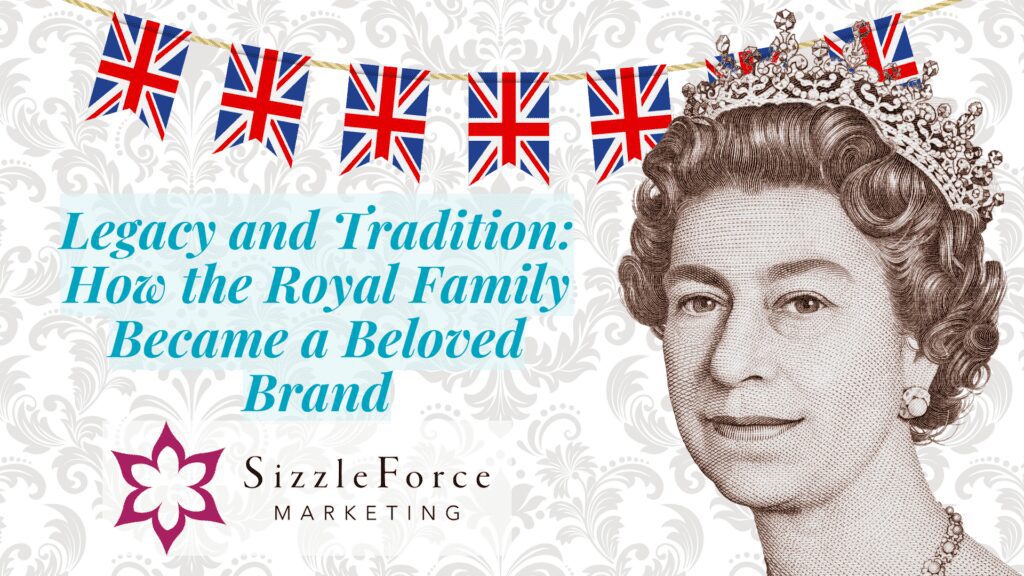My name is Leanne, and I’m a Content Writer for SizzleForce Marketing.
I was born in London and spent several years of my childhood there. My mum was born and raised in Paddington and I have dual citizenship with the UK. My grandma Liz’s apartment was just around the corner from Buckingham palace and I visited it as well as the surrounding parks and gardens frequently as a little girl. I remember looking up at the gold-tipped bars and the iron gates and feeling a sense of awe.
In the past few weeks since the Queen’s passing, my family and I have been watching alongside millions of others as people grieve and pay their respects to Great Britain’s former monarch. I was surprised to find myself grieving alongside them. I keep thinking about Grandma Liz and how much she loved the royal family. She passed in November of 2019 and I miss her very much.
My mum put it best, I think:
“It’s like an entire country has lost its favorite granny.”
But it’s not just British citizens who are mourning the Queen. I was shocked to find that some of my American friends were feeling the loss as deeply as my mum. I was also excited and delighted to learn that we have a team member who has multiple books on the Royal family and is impressively knowledgeable about them! It seems as though everyone I know has been affected by this event, in some way or another.
I’m fascinated by how invested the world is in the Windsor family. So much so that I felt compelled to write about the impact the Queen has had. But, we are a marketing team. Our goal is to provide strategies to help others promote their businesses and find success while pursuing their dreams. And so, it is with that in mind that we attempt to answer the question:
What makes the Windsors so popular?
The Most Successful Heritage Brand in the World
There are many examples of companies that include their history in their marketing. They do so to give a sense of legacy and tradition. This is Coca-Cola selling vintage coke bottles, and Dom Perignon pulling its name from a myth surrounding a 17th-century monk of the same name. Heritage branding is a form of branding that relies on a combination of storytelling, history, and strong symbolism to better connect with its audience.
But what if instead of 1-200 years you had over 1,000 years of history to back your brand?
It’s important to note that, as with the history of any country or government, the British Royal family is not without its share of controversy and bloodshed. It is also not as stagnant or stable a position as one might expect. In its 1,082-year history, there have been multiple civil wars that eventually restricted the monarchy’s regal authority in 1689.
This means that even in the tumultuous time of the French and American Revolutions, the King was more a “symbol of heritage” than a director of state affairs. Because of this restriction of power, the British Royal family survived the 18th century. Now in the 21st, the King more closely resembles a Chief Marketing Officer than an Emperor. In a sense, the family is a marketing team; their first duty is to direct the perception of the country and provide a sense of stability in difficult times.
Let’s go back to the magic blend of attributes that makes a good heritage brand. The royal family has:
- Over a thousand years of history
- Symbolism and decorum from throughout that history
But what about their story…?
Accessible Exclusivity
In 2016 “The Crown” premiered on Netflix. It follows the life of Queen Elizabeth II, starting with her wedding in 1947. While the show is not without its controversies, allowing its production may have been one of the most powerful moves that the royal family could have made. Why? Because it’s given 73 Million Households access to their story.
This alongside their participation in major events and willingness to work with brands and film franchises gives the royal family a sense of accessibility. Examples of this include the Queen’s participation in the opening ceremony of the 2012 Olympics and partnering with Paddington Bear during her Diamond Jubilee.
It’s not all accessibility, though. There’s also a sense of exclusivity and refinement amongst the royal family that we often see with luxury brands. For example, have you ever tried to find pictures of a royal family member in sweatpants? It’s not totally impossible but it takes a bit more digging than we expected. That’s because they have a dress code. This dedication to decorum is something that puts them beyond the scope of simply being celebrities. They themselves are symbols within the royal brand.
Another example of this practice of placing the royal family just out of reach is their Instagram accounts. Prior to the passing of the Queen, King Charles had his own Instagram page. Upon becoming King, however, the Clarence House Instagram Page was updated with a statement indicating that it would no longer be a source of information. We no longer get access to King Charles as a person. Upon receiving the crown, he has become the Figure Head of the country and with that title comes greater exclusivity.
Merchandise
The reach of the British Monarchy has been manifested in consumer culture. If you go into any tourist shop or look online you can find the royal family’s face printed on coffee mugs, tea bags, and more. Of course, with events such as Jubilees, weddings, and holidays these materials may be equal parts trinket and treasure. They also serve as a way for people to feel as though they’re taking a piece of the monarchy home with them.
In terms of heritage branding, we go back to Coke’s heritage store. To have merchandise, you have to have fans. By providing merchandise, you give your fans a way to express themselves and feel as though they’re participating in your brand. It’s a great way to increase engagement.
Putting the People First
Every CMO knows that the perception of your company can be directly influenced by your relationship with customers and fans of your brand. After the Queen’s passing, stories began pouring out about her kindness, her gentle nature, and her good humor. Some examples are:
- Wearing bright colors in public so people could spot her easily
- Remembering people, regardless of their status, even years after meeting them
- Her incredible sense of humor, and being unafraid to make herself the butt of the joke
- Her dedication to her family
These stories weren’t just from heads of state. Everyone who interacted with Queen Elizabeth seems to have had a shared experience of politeness, thoughtfulness, and a distinct understanding that she was representing more than just herself when she interacted with the public.
There is also a vast amount of charity work done by the Royal family. For example, Prince Harry founded the Invictus Games for Wounded Warriors. King Charles has 18 different charities as well. And of course, Princess Diana was famous for her incredible charity work and graciousness toward people.
Appreciating the Legacy
Queen Elizabeth II reigned for 70 years, making her the longest reigning monarch in British history. There is no denying that her dedication to the position and understanding of her responsibility as a figurehead directly shaped the world’s perception of the monarchy.
Through wars, environmental crises, recessions, and political strife she carefully remained non-partisan and cognisant of her responsibility to ensure that the Royal Family’s status is one of consistency and loyalty to its people. She has ensured that the Royal Family’s impact on the modern zeitgeist is impossible to ignore.
It is impossible to predict how our perception of the Windsors may change with King Charles as the head of the family and the head of the country. We can say that their unique blend of history, symbolism, exclusivity, accessibility, charity work, and merchandising has marked them as some of the most well-known figures in the world.




